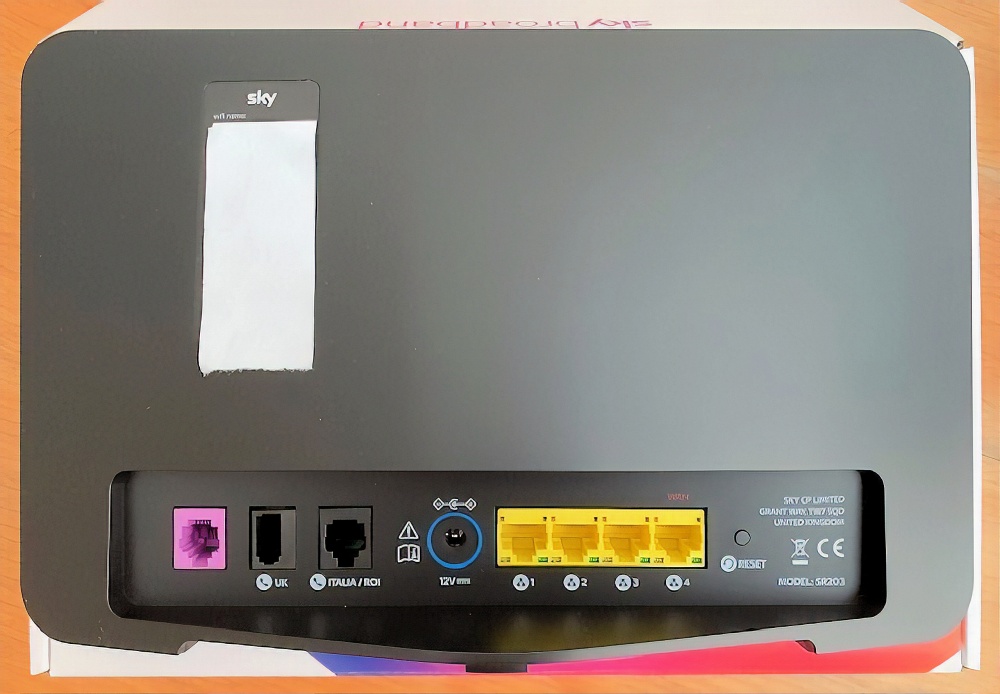Pictured – UK ISP Sky Broadband’s New SR203 Wireless Hub Router UPDATE
Customers taking part in Sky Broadband’s new SOGEA product trial are also being provided with a new router (SR203), which is probably the long awaited successor to their current Sky Q Hub (ER110) device and will most likely be shipped alongside future G.fast and FTTP based “ultrafast broadband” packages (possibly FTTC).
Sky first confirmed that they were developing a new router last year but they’ve refused to say anything more since then, although we’ve long assumed that it would surface alongside their future Openreach based Sky Ultrafast Broadband packages (currently expected to arrive around the very end of 2019).
Not long ago we became aware that Sky had started shipping a new router alongside their Single Order Generic Ethernet Access (SOGEA) product trial. For those who aren’t familiar with SOGEA, this is the new Openreach product that allows copper and hybrid fibre connections to be sold as broadband-only services (i.e. no analogue phone / voice product), although you can still optionally add a phone service later via VoIP.
Advertisement
The good news is that we now know a little more about Sky Broadband’s new “Sky Broadband Hub” thanks to a leak of some details into our inbox. At this stage the information is limited but the new router is of a similar size to the current Sky Q Hub, albeit with 4 x Gigabit LAN ports (the Q Hub only had two) – one of which is for WAN – and 2 x Telephone ports (almost certainly an ATA for VoIP connection via older analogue handsets).

The eagle eyed among you will no doubt spot that one of the two phone ports is marked for use in Italy and Ireland, which suggests that Sky will probably be using the same kit across their various other outlets. Indeed we’ve heard that some users on their 1Gbps package in Ireland have received a router with a similar model code (SR200), although this one seems to be an update of that and the final design may yet change.
A little bit of anecdotal testing suggests that its WiFi performance could be at least comparable to the BT Smart Hub 1/2, although our industry sources have previously indicated to us that Sky were aiming to be a lot faster than that. Naturally it would take some much more rigorous testing in order to establish how fast the new router can really go. We may have some more details later.
Advertisement
UPDATE 21st June 2019 @ 7:13am
As promised we have a few extra details to share, not least the fact that Sky Broadband have now added the “Sky Broadband Hub” (aka – Hub 4) router to their website, which among other things confirms that will be its real name (details). Apparently G.fast customers (yes it’s still coming) can expect to receive a Grey coloured version of this kit, while others will get the Black model (pictured above).
Separately we understand Sky has told their staff that the new Hub is coming “very soon” and has been designed to give customers Sky’s “best WiFi performance ever,” which is something you could say about any new router as they always get faster. The unit also has an extra antenna (total of 8) vs the older Sky Q Hub.
We’ve also had it pretty well confirmed now that ALL “Ultrafast” customers (G.fast/FTTP) will get the new Sky Broadband Hub when that service launches in the near future and all “Superfast” (FTTC / VDSL2) customers who take Sky’s new SOGEA based internet calls (VoIP) service can also expect to receive it, although normal superfast customers will be stuck with the Sky Q Hub unless they upgrade.
Advertisement
Our sources indicate that Sky will position this kit as being comparable in performance to TalkTalk’s Wi-Fi Hub and BT’s Smart Hub 2 routers.
Finally, we’ve been asked about the status of Sky’s long awaited “ultrafast broadband” (G.fast and FTTP) packages. As stated in prior articles, we know for certain that Sky’s FTTP service (Openreach) is due to launch during the second half of 2019 and all of the indications we’ve seen suggest that this will be toward the tail end of the year.
The new router announcement confirms that they will also be launching the Sky Broadband Hub for G.fast lines and we still expect this to arrive sooner than FTTP but Sky could easily launch them together (might make more sense). The “average” advertised speeds for these products will be as follows (we didn’t know for certain about the upload rates until today).
Sky Broadband Ultrafast 1
Download Speed 145Mbps
Upload Speed 27MbpsSky Broadband Ultrafast 2
Download Speed 285Mbps
Upload Speed 45Mbps
Mark is a professional technology writer, IT consultant and computer engineer from Dorset (England), he also founded ISPreview in 1999 and enjoys analysing the latest telecoms and broadband developments. Find me on X (Twitter), Mastodon, Facebook, BlueSky, Threads.net and Linkedin.
« 6G Internet Aim Gigabit Wireless Broadband at 4 Million UK Homes

















































Comments are closed